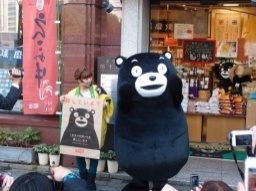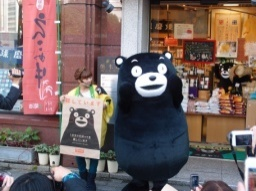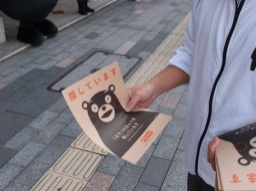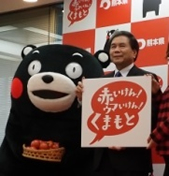
- Expertise
Branding
Summary
For this unique and entertaining campaign, Dentsu Kyushu and PRCD came to the aid of the authorities of Japan’s Kumamoto Prefecture, enhancing the area’s reputation as a major food producer, particularly of red-colored food. Utilizing the popularity of Kumamoto’s mascot Kumamon, known for his distinctive red cheeks, a surprising “incident” was manufactured which prompted a flood of attention from the media and general public, enabling the prefecture to more effectively promote itself as the home of delicious, red-colored food. The project is a fine example of the power of an original concept to capture the imagination of the public.
Statement of the Problem / Opportunity
Japan’s Kumamoto Prefecture, on the south-western island of Kyushu, is a rich agricultural region where a wide range of fruits and vegetables are grown. In particular, Kumamoto produces many kinds of red-colored food, including tomatoes, strawberries, water melons and beef. The prefectural authorities had endeavored to brand Kumamoto as the “red prefecture”, not only for its red produce but also because Japanese associate red with the positive qualities of leadership, hospitality and passion. However, their efforts had achieved limited results, with relatively few people connecting Kumamoto with the color red. Instead, green was the color that was most commonly associated with the prefecture and its status as a top food producer was not widely known.
On the other hand, Kumamoto’s most successful recent export was its cuddly bear-like mascot character Kumamon, who enjoys great fame among children and adults across the nation. It even made the headlines of international media such as The Guardian and Wall Street Journal. Dentsu Kyushu and its sister agency PRCD struck on the idea to exploit this fame to the benefit of Kumamoto. Positioning the character as the focal point of a story inspired by a well-known Japanese saying would attract a high level of notice for the incident and the subsequent campaign message. The organizers hoped that raising public awareness about Kumamoto’s prominence as a food-producing region would prompt sales of the prefecture’s produce to rise in turn. This would benefit the area financially, in particular its citizens involved in agriculture. In addition, the increased media attention on Kumamoto would lift the morale and pride of the local population, the prefecture believed.



Research
An online survey conducted by Dentsu Kyushu in January 2013 among 2,000 consumers nationwide found that only 16.5% associated Kumamoto with the color red. By comparison, the neighboring prefecture of Kagoshima, which was known for its “black pork”, had an association ratio with the color black of 26.7%. Also, having debuted in March 2010 as part of a prefectural tourism promotion campaign, Kumamon is now Japan’s most popular mascot character. Yet despite this accolade, many Japanese were unaware that Kumamon’s cheeks represented Kumamoto’s delicious red food..
Planning and Target Audience
The campaign was targeted at the general public, especially those people living in the most influential Tokyo region. To grasp the public’s immediate attention, news of an incident involving Kumamon was released to the media, specifically the mysterious disappearance of the cute character’s trademark rosy red cheeks. The agencies created a story based on the Japanese saying that eating delicious foods makes your cheeks fall off, with the real reason of his cheeks’ disappearance to be divulged when they were found at the end of the campaign. In addition to utilizing Kumamon’s “celebrity” power, the unusual and interesting nature of the story would help to garner widespread exposure via mainstream and online news media as well as social media. By encouraging the public to assist in the search for the missing cheeks, consumers would feel more invested in its outcome. Once the public’s attention was firmly fixed on the story, the campaign’s underlying purpose would then be divulged, and the link between Kumamon’s missing cheeks and the delicious red food of Kumamoto would be driven home. In this way, the campaign slogan of “Red, delicious Kumamoto prefecture” would reach the largest possible audience and be retained in the nation’s collective memory, resulting in a stronger identity for the region.

Execution
Leveraging the Japanese saying that delicious foods make your “cheeks fall off”, the agencies created a story that Kumamon had lost his cheeks after enjoying Kumamoto’s tasty foods. In the campaign’s initial phase however, no link was overtly drawn between the saying and the mystery. The story was broken through a press conference, at which the Governor of Kumamoto solemnly announced the shocking news. Meanwhile, posters were put up and fliers distributed in busy shopping areas in Tokyo appealing for public assistance with the search. Over subsequent days, Kumamon appeared at public events and on TV without his cheeks, building the story’s momentum. Furthermore, social media sites were fully utilized, with a cheek-less Kumamon replacing the character’s usual Twitter and Facebook profiles; regular search updates, including photos, were posted. Kumamon even made a visit to the headquarters of the Tokyo Metropolitan Police Department, where he submitted an official report of loss. Images of Kumamon with Peepo-kun, a mascot of Tokyo Metropolitan Police Department, were shared with consumers via its official website and social media. In response to the search appeals, there were thousands of Tweets from members of the public claiming to have “found the cheeks”.
Then, four days into the search, the Governor called another press conference to announce that the cheeks had been “found” and the episode’s true promotional aim was revealed, with Kumamoto’s delicious red food identified as the cause of Kumamon’s lost cheeks. The campaign message of Kumamoto-equals-delicious red food was actively promoted through news and entertainment media, aided by the cooperation of a number of well-known celebrities. A specially created campaign website, online video, smartphone game and picture book also lent fun support. As a follow-up initiative to thank those who had helped in the search, special gift boxes containing Kumamoto tomatoes were produced, called “arigatomato” (a pun combining the Japanese word for “thank you” and “tomato”).

Campaign Outcomes / Monitoring and Evaluation
The incident of Kumamon’s missing cheeks, and their subsequent discovery, earned Kumamoto wide exposure in the media as a food-producing region, with 23 TV shows, 30 newspaper articles and over 400 websites running the story. This led to a 10% year-on-year increase in Kumamon-branded food sales in 2013, even though the main part of the campaign was only executed in the year’s final quarter. Also, over 10,000 applications were received for the lottery of 100 special boxes of Kumamoto tomatoes as part of the “arigatomato” initiative. And whereas in 2012 the public had mostly associated the color green with the prefecture, by 2013 red was firmly established as its No.1 brand image color. The top local newspaper Kumamoto Nichinichi Shimbun declared in a November 9 article, “this unique PR campaign focusing on Kumamon’s missing cheeks is a success” and the people of Kumamoto recognized the PR efforts of Kumamoto Prefecture.
受賞歴
- WOMMY Awards
2014Bronze Award Category: Engagement
- Spikes Asia
2014Silver Award Category: PR – Brand Voice
- Asia Pacific SABRE Awards
2014winner Category: Japan
- Global SABRE Awards
2014World’s 50 Best PR Programs Category: Non-Corporate ― Economic Development
- PR WEEK Awards Asia
2014Promotional Activity of the Year



